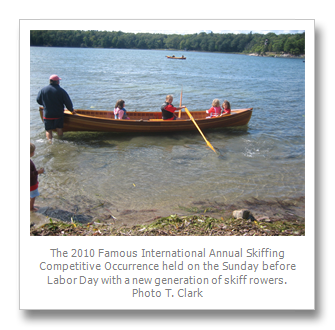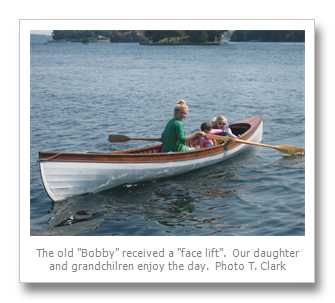Editor’s Note: Tad Clark checked TI Life for information on the St. Lawrence Skiff ( the "Skiff" ) and found very little. So, he did his research, and very kindly has provided our first article on the Skiff. If you have other Skiff stories, please add them to our "Comments" section below.
Our 1902 St Lawrence Skiff “Bobby” was my salvation as a teenager. It was 1961 and our cottage on Comfort Island was easy rowing distance from Alexandria Bay, NY. To wait for a ride with my father in the unreliable displacement launch “Buzz” was to wait all day. The more I rowed, around the bays, channels and islands, the more I appreciated what a superb craft the St Lawrence Skiff is.
Pointed at both ends, its construction is more substantial than that of a canoe or kayak. Moving a Skiff overland, by hand, is impossible for one person. With a minimum weight of about 250 pounds, and a length of 17-22 feet, it is a demanding task for two people to move a Skiff. However, it's a different story when in the water as the Skiff has superior gliding-and-tracking characteristics once the rower gets up-to-speed.
While most skiffs are intended for rowing, many had a removable mast and could be sailed without a rudder or even a centerboard by someone who took the time to learn the proper skills. Some skiffs had the stern end squared off to accept a one-cylinder motor.
Barton Haxall, an expert on Skiffs, and head librarian for the Antique Boat Museum in Clayton, NY, characterized these motorized Skiffs as “wet and not very efficient. People would typically turn off the motor and grab the oars to land.”
The heritage of the Skiff was rooted in “European prototypes” according to Bonnie Wilkinson in a 1985 article written for the Shipyard Museum which was renamed the Antique Boat Museum in 1990. Mr. Haxall, and other experts agree that the design and functionality of the St Lawrence Skiff was more of an “evolution than a single invention. Various accessories and components were improved upon and included as standard equipment over time.”
The Shipyard article identifies Xavier Colon of Clayton as the first “mass producer” of skiffs, probably in1873. In 1878 Colon created a partnership with Alexander Bain, a travelling dentist. In the mid-1880s, Dr. Bain became the sole owner. Mr. Haxall believes that many people built their own Skiffs in those early years. However, the Skiff was very popular as by 1908 there were ten Skiff builders in Clayton and boat liveries were a part of most waterfront communities.
There is a four-panel-painted mirror in our Comfort-Island cottage depicting the popular activity known as the “fishing picnic”. The family's steam yacht, “Mamie C”, is towing three Skiffs on the first panel. The second shows family, and guests, fishing from the Skiffs and the third panel depicts an elaborate table setting, complete with linens for dining on the catch - known then-and-now as a “shore dinner.” The fourth panel shows the yacht and Skiffs heading home, into the sunset.
People of more-limited means often patronized the area's boat liveries to participate in what had become known as a sportsman’s-fishing paradise. The liveries offered guided-fishing outings and transportation – all for a modest price.
In those days the guides were called “oarsmen” and by 1880s and 1890s these rugged individuals would have qualified as elite athletes in present-day terminology.
A 1973 Thousand Islands Sun article portrays these oarsmen as guides of the highest caliber, anywhere! "Most of their skiffs were twenty-two feet in length. . . they kept their Skiffs shining like a piano . . . they took great pride in their boats.” The author reports that these guides “are always anxious to do all they can for your comfort and to get you a good catch of fish.” They carried about a hundred pounds of necessities - a 30-40 pound anchor, folding chairs, utensils for cooking and eating, and a folding table for the “shore dinner”.
For approximately $3.00, the early-Clayton “oarsmen” would row, for about 30 miles, a pair of customers around Howe Island, cook a “shore dinner”, and return to Clayton. I am one of the many who have rowed around Wellesley Island, a similar distance, in a single day. However, I rowed alone and had no gear for an elaborate picnic.
Inside the Thomson’s Skiff Livery. Photo courtesy Pine Tree Point
“Cap” C.S. Thomson ran a livery in Alexandria Bay in the 1890s. Cap progressed from rowing people in his Skiff to purchasing his first tour boat and then to owning a major portion of the town. His grandchildren own shops, the “Uncle Sam” tour-boat line, resort hotels and other businesses. All have their origin in the wealth he accumulated through his willingness to work harder than his peers while building up his businesses.
Original catalogues from the Xavier Colon-Dr.Alexander Bain partnership can be found in the Antique Boat Museum archives and are titled “Illustrated Catalogue of St Lawrence Skiffs”. The 1885 catalogue is in exceptionally good condition and one has to smile when reading its price list. The most basic Skiff is listed for $70 and the top of the line model is $100. Blue Heron Boat Works, on Wellesley Island, currently lists a new Skiff at $12,000 with used Skiffs from $3,000-$10,000.

Testimonials included in the 1885 Bain-Colon catalogue make for entertaining reading and indicate high praise for the quality and workmanship of these early Skiffs. Charles Emery, a tobacco millionaire, had 6-8 Skiffs at Calumet Island, near Clayton, and wrote, “No fault of any kind can be found with them as regards their beauty or strength, and as sea boats they have no superior.” Thomas Carter of Oneida Lake, near Syracuse, wrote, “It is really the nicest and best rowing boat I ever was in, and I can only laugh at my old notions of a row boat.”

One modern-day group of enthusiastic Skiff owners convenes on the Sunday before Labor Day each year to celebrate the St Lawrence Skiff with a wide variety of races in an event called FIASCO (Famous International Annual Skiffing Competitive Occurrence). 2010 marked FIASCO's 30th anniversary of these races which take place at Laundry Point on Wellesley Island. The races feature men, women, and children's categories and the popular “bag race” - one rower is blind-folded and the rider gives the directions.
St Lawrence Skiffs still thrive and "Bobby” received a "face lift", a few years ago. My wife, and daughter, row her often and although I use her less. I will never tire of the beautiful-and-clean lines of her hull and the quiet contemplation afforded me as I glide, silently, through my River neighborhood.
By Tad Clark, Comfort Island
Tad, a fourth-generation, summer resident of Comfort Island, has been a tennis coach for over 35 years. His growing interest in freelance writing includes commentaries for the TI Sun and the history of Comfort Island: www.comfort-island.com.